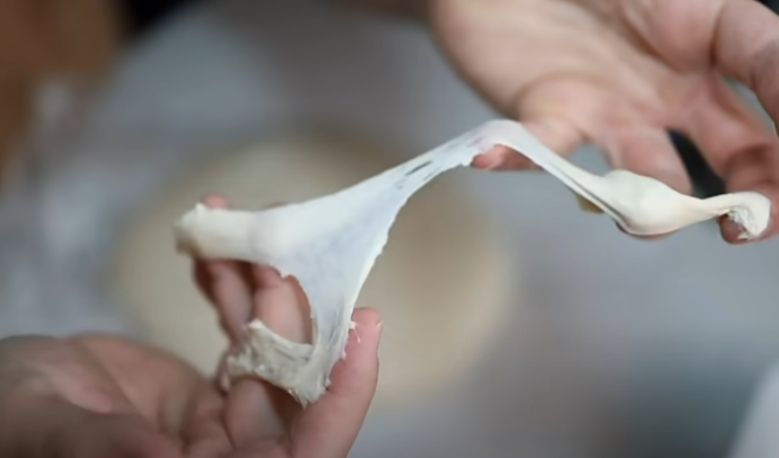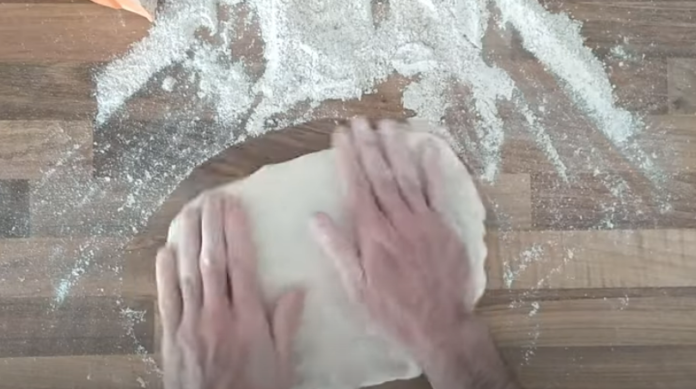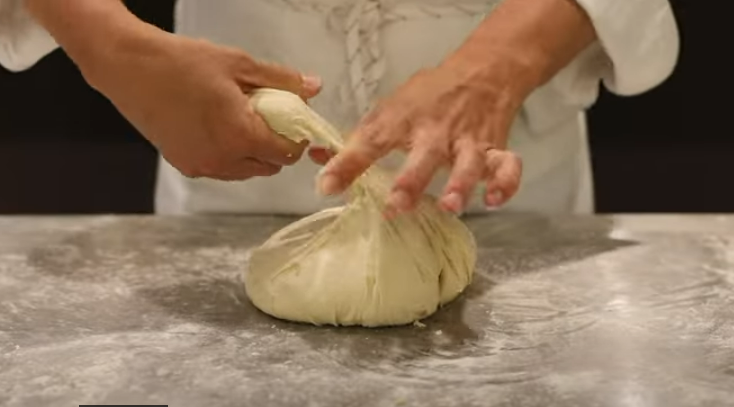Your pizza dough is shrinking because it lacks proper gluten development and/or yeast activity during the rising process. This can be due to over-fermenting the dough or using too much yeast.
Are you frustrated by your pizza dough shrinking during the baking process? Perhaps you’ve meticulously followed your recipe, but your dough still fails to maintain its size and shape. Don’t worry, you’re not alone. A less-than-perfect pizza crust is the result of this widespread problem, which can have several causes.
We’ll delve into the reasons why your pizza dough may be shrinking and explore some potential solutions to help you achieve that desired fluffy and stretchy crust that pizza lovers crave. By understanding the science behind dough shrinkage, you’ll be better equipped to troubleshoot and perfect your pizza-making skills. So, without further ado, let’s uncover the secrets to combating shrinking pizza dough.
Common Reasons For Pizza Dough Shrinking
One common reason for pizza dough shrinking is over-kneading, which causes gluten to tighten excessively. Using cold dough straight from the fridge can also lead to shrinking during baking due to its lack of proper relaxation. Additionally, stretching the dough too thin or inadequate proofing may contribute to pizza dough shrinkage.

Improper Mixing Technique
- Using the wrong mixing methods can lead to pizza dough shrinking.
Insufficient Resting Time
- Allowing inadequate resting time causes pizza dough to shrink during baking.
- When mixing the pizza dough, ensure to evenly combine all ingredients.
- Let the dough rest for sufficient time to enable gluten to relax properly.
Impact Of Ingredient Choices
When it comes to making the perfect pizza dough, the choice of ingredients plays a crucial role in determining the outcome. Each ingredient has a unique impact on the dough, and understanding how they interact can help troubleshoot issues like dough shrinkage. Let’s take a closer look at two key ingredient choices that can affect your pizza dough: flour selection and yeast quality.
Flour Selection
Flour is the foundation of any pizza dough, and its characteristics can significantly impact the texture and structure of the final crust. The type of flour you choose, whether it’s all-purpose, bread flour, or even a blend of whole wheat and all-purpose flour, will affect how your dough behaves.
Different flours have varying protein content, which directly influences gluten formation. Gluten is the protein responsible for giving dough its elasticity and structure. A flour with a higher protein content, like bread flour, will produce a chewier and more elastic crust. On the other hand, all-purpose flour, with a lower protein content, may result in a softer and more tender crust.
Apart from protein content, you might also consider experimenting with different types of flours to achieve the desired texture. For example, using a blend of whole wheat and all-purpose flour can add a nutty flavor and create a more substantial, rustic crust.
Yeast Quality
Yeast is a living organism that plays a crucial role in dough fermentation. The quality and freshness of your yeast can have a significant impact on how well the dough rises and holds its shape during baking. Using old or expired yeast can result in insufficient fermentation, leading to a lack of rise and subsequently causing the dough to shrink.
It’s essential to ensure that your yeast is alive and active. Instant or active, dry yeast is the most commonly used yeast for pizza dough. Rehydrating the yeast in warm water before mixing it with the flour can help activate its fermentation process.
In addition to yeast quality, the amount of yeast used also affects dough rise. Using too much yeast may cause the dough to rise excessively, leading to air bubbles and subsequent shrinkage. It’s important to follow the recipe’s recommended yeast amount to achieve the desired results.
By carefully considering your flour selection and yeast quality, you can troubleshoot the issue of dough shrinkage and enjoy a perfectly delicious and well-risen pizza crust every time.
Role Of Temperature And Humidity
Temperature and humidity play a crucial role in the elasticity of pizza dough. Understanding the impact of these environmental factors is essential for creating the perfect pizza.
Effect On Dough Elasticity
Temperature and humidity directly affect the elasticity of pizza dough. High temperatures and low humidity can lead to rapid evaporation of moisture from the dough, causing it to shrink. Conversely, cold temperatures and high humidity can make the dough overly moist, resulting in a lack of elasticity and a soggy crust.
Temperature changes can cause the dough to contract or expand, altering its elasticity and texture. The balance between temperature and humidity is essential for achieving the ideal dough consistency.
Preventative Measures
To maintain optimal dough elasticity, it’s crucial to control the temperature and humidity during the dough-making process. Consider the following preventive measures:
- Store ingredients in a cool, dry place to prevent moisture absorption.
- Use a proofing box or warm area to maintain consistent temperature and humidity during the rising process.
- Adjust the flour-to-water ratio based on the environmental conditions to achieve the desired dough consistency.
- Monitor the dough closely during the resting and rising stages to ensure it’s not overexposed to fluctuating temperatures and humidity levels.
By implementing these measures, you can minimize the impact of temperature and humidity on pizza dough elasticity, resulting in a perfect, consistent crust every time.
Proving And Kneading Techniques
Are you wondering why your pizza dough keeps shrinking? The culprits might be your proving and kneading techniques. Properly proving and kneading your dough is vital for achieving the perfect pizza crust. In this section, we’ll delve into the importance of proper proving and kneading for dough structure. Let’s uncover the secrets to preventing that frustrating shrinkage.
Importance Of Proper Proving
Proving, also known as rising, is the crucial step in pizza dough preparation. During proving, the yeast ferments the sugars in the dough, producing carbon dioxide gas that forms air pockets, leading to the desired light and airy texture. Insufficient proof can result in a dense, tough crust. Overproving, on the other hand, can cause the dough to become too weak, leading to collapsing or shrinking during baking. To ensure the perfect rise, find a warm, draft-free spot for the dough to prove in and allow it enough time to double in size.
Kneading For Dough Structure
Kneading is the process of working the dough to develop the gluten, which gives the dough its structure and elasticity. This step is crucial in preventing the pizza dough from shrinking excessively during baking. Proper kneading ensures a uniform texture, proper rise, and a chewy yet tender crust. Be mindful not to over-knead, as this can result in a tough, dense crust. Aim for a smooth and elastic dough, which indicates that the gluten has developed sufficiently.
Understanding Oven Conditions
One of the key factors that can affect the size and texture of your pizza dough is the oven conditions. Without a proper understanding of oven heat distribution and the baking surface, your dough may shrink and not achieve the desired results. In this section, we will dive into these aspects and explore how they can impact your pizza-making process.
Heat Distribution
Your oven’s heat distribution plays a vital role in ensuring that your pizza dough bakes evenly. Inadequate heat distribution can result in uneven cooking, causing the pizza dough to shrink or remain undercooked in certain areas. Understanding how heat is distributed in your oven can help you make necessary adjustments to achieve better results.
Here are a few reasons why uneven heat distribution may occur:
- Blocked vents or clogged fan: If your oven has vents or a fan, make sure they are not blocked or clogged. Proper ventilation is crucial for even heat distribution.
- Improperly positioned racks: Placing your pizza dough too close to the oven walls or rack extremes can lead to uneven cooking. Ensure that you position the racks in the middle of the oven for balanced heat circulation.
- Inconsistent temperature regulation: Ovens may have hot spots or areas where the temperature is not consistent. Issues with oven calibration or faulty heating elements are just two examples of the causes of this. Using an oven thermometer can help identify these areas and allow for necessary adjustments.
Baking Surface
The choice of the baking surface can greatly impact your pizza dough’s final results. Different surfaces, such as pizza stones, baking sheets, or perforated pans, have varying heat retention and transfer properties.
Let’s take a closer look at some common baking surfaces:
| Baking Surface | Heat Retention | Heat Transfer |
|---|---|---|
| Pizza Stone | High | Even |
| Baking Sheet | Medium | Moderate |
| Perforated Pan | Low | Quick |
Choosing the right baking surface can help ensure an even distribution of heat and prevent excessive shrinkage of your pizza dough. Experimenting with different surfaces and observing the results can guide you in finding the most suitable option for your desired pizza texture.
Evaluating The Dough Stretching Process
Evaluating the Dough Stretching Process:
Techniques For Hand-stretching
- Start with a round ball of dough.
- Use your hands to gently press and stretch the dough.
- Rotate the dough to maintain an even thickness.
Tools For Even Thickness
- The pizza peel helps lift and maneuver the dough.
- A rolling pin ensures uniform thickness.
- Bench scraper for precise cuts and adjustments.
Hand-stretching pizza dough is a critical step in achieving the perfect pizza. Utilizing proper techniques and tools can prevent dough shrinkage.
Optimizing Toppings And Sauce
When it comes to optimizing toppings and sauce for your pizza, it’s important to consider the effect on dough rise and how to balance ingredients for consistency. The toppings and sauce play a crucial role in the overall quality of your pizza, and understanding their impact on the dough is essential for achieving the perfect crust.
Effect On Dough Rise
The choice and distribution of toppings and sauces can directly affect the rise of the pizza dough. Heavy or moisture-rich toppings can weigh down the dough, causing it to shrink during the baking process. It’s important to carefully consider the moisture content of toppings and sauce to ensure that the dough can rise properly during baking.
Balancing Ingredients For Consistency
Balancing the ingredients, including toppings and sauce, is crucial for achieving consistent pizza dough. By ensuring that the toppings are evenly distributed and not overly dense in any particular area, you can prevent the dough from shrinking unevenly. Consistency is key when it comes to creating the perfect pizza crust, and carefully optimizing the toppings and sauce is a significant part of achieving that goal.
Troubleshooting Solutions
Experiencing shrinking pizza dough can be frustrating, especially when you’re eagerly anticipating a delicious, perfectly cooked pizza. However, there are several troubleshooting solutions you can try to rectify this issue and ensure your pizza dough retains its shape and size. These solutions focus on adjusting recipe ratios and implementing post-baking remedies.
Adjusting Recipe Ratios
An imbalanced recipe can often be the culprit behind shrinking pizza dough. Consider the following solutions to adjust the ratios and improve dough consistency:
- Increase hydration: Adding slightly more water to the dough mixture can help improve elasticity and prevent shrinkage. Experiment with small increments until the desired consistency is achieved.
- Add more flour. If your pizza dough is too wet, it may shrink during the baking process. Incorporate additional flour gradually until the dough becomes easier to handle and less prone to shrinkage.
- Optimize yeast quantity: Using too much yeast can cause the dough to rise too quickly and then shrink. Ensure you follow the recommended yeast-to-flour ratio provided in your recipe.
- Extend fermentation time: Allowing your dough to ferment for longer periods can enhance the gluten structure, resulting in a more robust and resilient dough. Consider refrigerating the dough overnight for a slow rise.
Post-baking Remedies
If your pizza dough still shrinks even after adjusting the recipe ratios, try implementing the following post-baking remedies:
- Preventing excessive moisture: A common reason for shrinking pizza dough is excessive moisture retention during baking. To prevent this, ensure your toppings do not contain high-water content ingredients and consider pre-cooking certain toppings to remove excess moisture.
- Prick the dough. Before adding your toppings, lightly prick the dough with a fork. This helps release any trapped air, reducing the chances of the dough shrinking during baking.
- Slower cook time: Reducing the oven temperature slightly and extending the cooking time can help prevent rapid expansion and contraction, reducing the likelihood of shrinking dough.
- Proper cooling: Allow your pizza to cool for a few minutes after removing it from the oven to prevent rapid temperature changes, which can cause the dough to contract and shrink.
Frequently Asked Questions Of Why Is My Pizza Dough Shrinking
Why Does My Pizza Dough Shrink During Baking?
When pizza dough shrinks, it’s often due to underdeveloped gluten, improper shaping, or insufficient proofing. Ensuring proper kneading and relaxation of the dough, as well as allowing it to come to room temperature before shaping, can help prevent shrinkage during baking.
How Can I Prevent My Pizza Dough From Shrinking?
To prevent pizza dough from shrinking, ensure thorough kneading to develop gluten, proper shaping techniques, and adequate proofing time. Allowing the dough to rest and come to room temperature before shaping and baking can also help minimize shrinkage and result in a better crust.
What Are Common Mistakes That Lead To Pizza Dough Shrinkage?
Under-kneading, over-flouring during shaping, and rushing the proofing process are common mistakes that can lead to pizza dough shrinkage. Additionally, using cold dough directly from the fridge or not allowing it to relax before shaping can contribute to shrinkage during baking.
Conclusion
Understanding why your pizza dough is shrinking is crucial for achieving the perfect crust. Factors such as yeast activity, gluten development, and dough-handling techniques can all contribute to shrinking dough. By using the right ingredients, kneading properly, and allowing the dough to rest, you can minimize shrinkage and create a delicious, puffy crust.
Experimenting and fine-tuning your dough-making process will help you master the art of pizza making. Happy baking!



